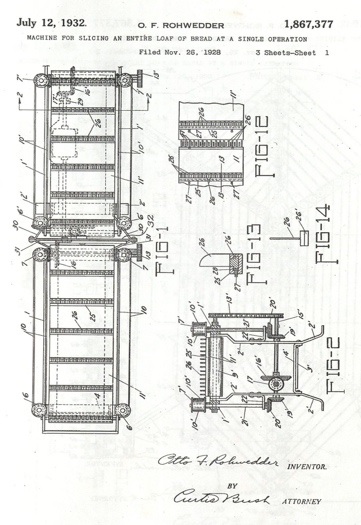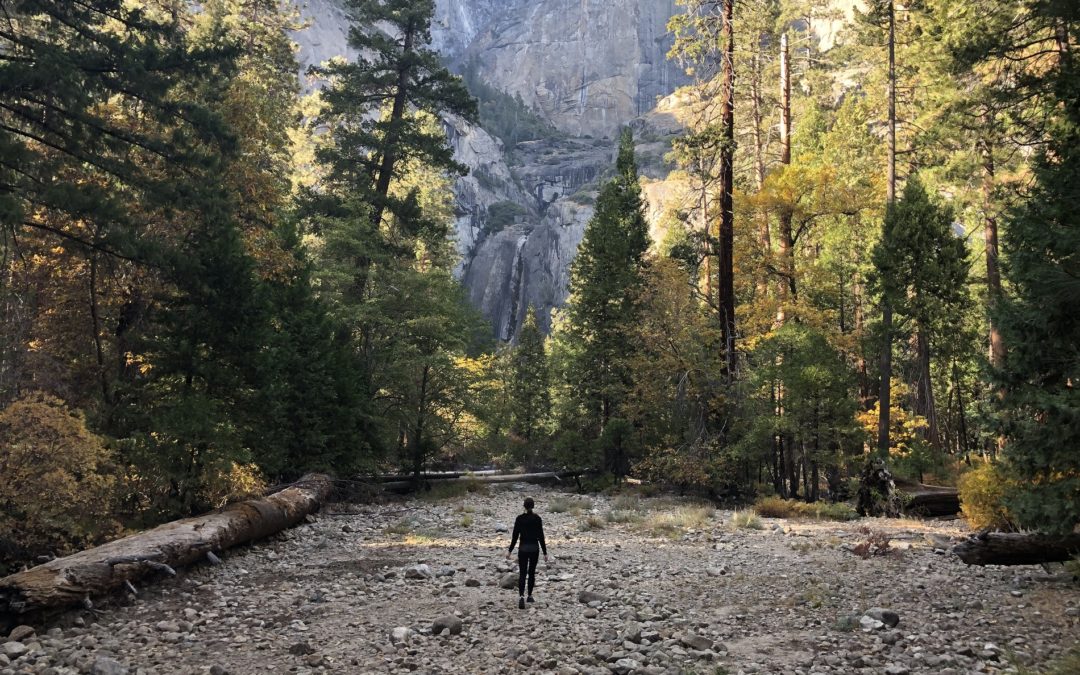Art by E.G. Cunningham
Wonder Time – A Meditation
The Matter at Hand
The scientist asks us to think of time as a loaf of bread.
What he doesn’t say is how we might connect now to then—if only we would cut right down the middle.
One day, long ago, now, someone has had the idea for an easier sandwich. They section the loaf into horizontal slices of equal width, a calculation that for the rest of time is recalled whenever anyone utters the words the best thing since sliced bread, which is exactly how we got locked in, ever separated from our previous lives, our future moments, which are, in all, everpresent.

For our experiment in eternalism, the baguette works best. Take a serrated knife and pull the blade through from top to bottom. Notice how each half mirrors the once-whole shape. If time is a loaf of bread, we might think of our vertical motion as conjoining all moments of future-present-past. Go ahead—take a bite. It tastes better when torn with both hands. Good. You are now chewing the timeless existence.
Having established our analogy, let us meditate on how those vertical time-slices might manifest. Here are several cases, in no way comprehensive. The comprehensive is a study for another time, in parallel lines to a place called Athens—Greece, perhaps, where two young scholars bow their heads over future-ancient texts, refining their horology.
Eternalism Case Study 0.0
Two young scholars bow their heads. They sit at a particleboard desk, which rests against a window, which overlooks a spring-green quad in the center of Athens. A faint Magnolia scent drifts invisibly beyond the library stacks. They sit at a long marble table in the center of the Acropolis, reading through stacks of papyrus; they are draped, sandaled, and hot; it is hot in both places; in both Athenses they reach for a cool glass of water.
Their study is horology: the nature and properties of time. The work is tedious, symbolic, and difficult, though they see its applications everywhere—in the faces of the workers at the edge of the city, in the Ilisos and Oconee Rivers, in the oratories of headmasters, where such words as level, truth, breaking, and place loop the ceilings like euphonias which travel over vast oceans. They are neither certain of nor disenchanted with this work. They cannot know, but feel somehow, a low, reverberating hum that seems to undergird every piece of ground on which they walk.
Eternalism Case Study 0.0.0
Killary Harbour is called Ireland’s only fjord, though this designation has been the subject of debate, owing to Lough Swilly’s and Carlingford Lough’s glacial shaping. Like Belfast, Maine, Killary owes much of its economy to tourism, of a localized and modest sort, evidenced by the boat tours which run from April to October. This is the living season, they know—they being those two young scholars, the pair that walks the sloping Front Street down to the docks. They scan the green-blue of the horizon, turn their faces into a cool breeze that hearkens to an omnipresent-past other Belfast, where once-now the shipyards teem with the sounds of metal on metal and the briny sharp smell of fish.
In Killary, an aged philosopher takes notes, believing language to be the sole construct of reality. He calls the land on which he sits the last pool of darkness. He writes, how small a thought it takes to fill a whole life, and, if one understands eternity as timelessness…
On the pedestrian bridge, a motley crew of men fish. In the night sky, a pair of looping fish swirls in opposing directions, a self-contained system, now a sign that is said to be mutable.
The Matter at Hand
The milk is milk, strange enough in its cool glass, the consistency and color of boredom or dreams. There is nothing wrong with it, the boy decides, save that it simply sits and waits. In love with the surprise of motion, he picks up the glass, throws the milk over his shoulder, and exclaims, Good milk!
Laughter. On the table, bread, perhaps. Sliced or whole, it is the same—now and then. The milk still in the glass, now cool, now warming in a vector of light. Elsewhere, in simultaneity, a man sits and waits. Is this it? Piece of cake—cut into shapes like a clock or a calendar. How much—space or time, added or subtracted—and how to calculate— rate of return, investment—how much or how little remaining? What to make of the so-far ingredients? And what next?
Eternalism Case Study 0.0.0
And a ship sails under an auspicious name like Prosperity or Alacrity, beginning at the far end of Penobscot Bay and aiming southward down the Intracoastal Waterway to a place called St. John’s or Dead River. The scholars grip the wooden railing and frown at the emptying harbor. Tourist season is over, as are its living symbols of long days, broad light, freedom, and ice cream. Autumn is here and winter will arrive soon after.
In winter, the suburban streets of Hammond take cover. Likewise, in Lowcountry, a rare freeze blankets the sandy roads in white powder.
In winter, she draws a heart on the hood of a car that will flood come summer.
In winter, he figures the words that constellate the figures bloom or pike, the blues and yellows redolent of water, spring, and summer.
Eternalism Case Study 0.0
In summer, a course of study is over—for a time. Two scrolls, as-yet unfurled, wait to arrive to a small metal box that reads 127, the atomic number of Unbiseptium, an element that has not yet been discovered. The home is a house connected to many such houses; it overlooks a copse of mulberry trees. Elsewhere, this is what she will hear to the tune of “The Wheels on the Bus”— the song echoing from the suburban ice cream truck at all seasons.
In summer, he waits in Lake County, wondering past the borders of now and then, projecting east, where he will soon begin a course of study near the White and Green Mountains.
In summer, she walks to the overlook address. Summer is empty in this Lake County. She longs for a cool glass of water. Soon she will leave for a city called Athens. Who will she meet there? What to make of the so-far ingredients? And what next?
The Matter at Hand
Out of sight, a replica clock sits. It recalls The Persistence of Memory. Of this piece, a critic writes, “the soft watches are an unconscious symbol of the relativity of space and time, a Surrealist meditation on the collapse of our notions of a fixed cosmic order.” The artist corrects her, noting that, in fact, he had merely considered a Camembert wheel as it melted.
Out of sight, three juggling pins rotate in space, their cascade kept in motion through coupled oscillation. In space, the astronaut demonstrates the magic trick with apples and oranges—and though these are the common ingredients for inapt comparisons, a study undertaken in serious jest by a California astrophysicist reads, “Such comparisons are not only possible, but show a great deal of similarity between the two fruits in contradiction of widely
held belief.”

Eternalism Case Study 0
Every-season takes hold in near-desert. The air thickens; the air thins; the air thickens again. The field drains of then inks with color. Across the street, a neon sign blazes Theater; an owl rests on a streetlight. Snow coming down under streetlights, this he and she remember. A rabbit emerges from a creosote bush; now the land is shaved and emptied of its previous-future forms. How sad, they say, occupying the then-now. And what-how of now-yet?
Beyond and here, a boy is born who discovers the wonder of every past-future lake and stretch of green, who understands the truth of glass full, glass empty, of the fresh material and the so-called final rendering. She sings to him this, in the spirit of the past-present-future: how wondrous to toss, wait, hold, and re-remember.
The Matter at Hand
The scientist asks us to think of time as a loaf of bread.
Rohwedder’s first machine (Patent No. 1867377A), not only sliced the bread, it wrapped each slice into sealed separateness. This invention was considered one of the greatest steps forward in baking.
The comparatively thinner, uniform commercial slices gave rise, pun intended, to increased bread consumption. Such consumption saw an at-pace increase in the demand for jams. Mulberry jam recalls the taste of similar blends; its unripe fruit can result in mild psychedelic experiences. A hallmark of such experiences is the so-called verticality of time. Other spreads, including apple butter and orange marmalade, remain quite popular.
Notes
Fig. 1, “Machine for slicing an entire loaf of bread at a single operation,” Otto F. Rohwedder, Patent No. 1867377A, 1928. https://patents.google.com/patent/US1867377A/en.
“How small a thought it takes to fill a whole life!” Ludwig Wittgenstein, Culture and Value, 1946.
“If we take eternity to mean not infinite temporal duration but timelessness, then eternal life belongs to those who live in the present. Our life has no end in just the way in which our visual field has no limits,” Ludwig Wittgenstein, Tractatus Logico-Philosophicus, 1921.
“The Persistence of Memory,” Salvador Dalí, 1931.
Fig. 2, “Apples and Oranges-A Comparison,” S A. Sandford. Annals of Improbable Research (AIR) Vol. 1, No. 3, May/June 1995.
About the author/artist:
EG Cunningham is the author of Ex Domestica (C&R Press). Her poems and prose have appeared in The Abandoned Playground, Colorado Review, The Gettysburg Review, The Nation, Poetry London, The Poetry Review, Salt Hill, and other publications. She holds an MFA in Creative Writing from the University of Iowa and a PhD in English from the University of Georgia. She teaches at the University of California, Merced.

